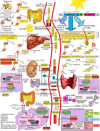Vitamin D for health: a global perspective
- PMID: 23790560
- PMCID: PMC3761874
- DOI: 10.1016/j.mayocp.2013.05.011
Vitamin D for health: a global perspective
Abstract
It is now generally accepted that vitamin D deficiency is a worldwide health problem that affects not only musculoskeletal health but also a wide range of acute and chronic diseases. However, there remains cynicism about the lack of randomized controlled trials to support the association studies regarding the nonskeletal health benefits of vitamin D. This review was obtained by searching English-language studies published up to April 1, 2013, in PubMed, MEDLINE, and the Cochrane Central Register of Controlled Trials (search terms: vitamin D and supplementation) and focuses on recent challenges regarding the definition of vitamin D deficiency and how to achieve optimal serum 25-hydroxyvitamin D concentrations from dietary sources, supplements, and sun exposure. The effect of vitamin D on fetal programming epigenetics and gene regulation could potentially explain why vitamin D has been reported to have such wide-ranging health benefits throughout life. There is potentially a great upside to increasing the vitamin D status of children and adults worldwide for improving musculoskeletal health and reducing the risk of chronic illnesses, including some cancers, autoimmune diseases, infectious diseases, type 2 diabetes mellitus, neurocognitive disorders, and mortality.
Copyright © 2013 Mayo Foundation for Medical Education and Research. Published by Elsevier Inc. All rights reserved.
Figures






References
-
- Holick MF. Vitamin D: extraskeletal health. Rheum Dis Clin North Am. 2012;38(1):141–160. - PubMed
-
- Hossein-nezhad A, Holick MF. Optimize dietary intake of vitamin D: an epigenetic perspective. Curr Opin Clin Nutr Metab Care. 2012;15(6):567–579. - PubMed
-
- Smit E, Crespo CJ, Michael Y, et al. The effect of vitamin D and frailty on mortality among non-institutionalized US older adults. Eur J Clin Nutr. 2012;66(9):1024–1028. - PubMed
-
- Holick MF. Nutrition: D-iabetes and D-eath D-efying vitamin D. Nat Rev Endocrinol. 2012;8(7):388–390. - PubMed
-
- Lucas RM, Ponsonby AL, Pasco JA, Morley R. Future health implications of prenatal and early-life vitamin D status. Nutr Rev. 2008;66(12):710–720. - PubMed
Publication types
MeSH terms
Substances
Grants and funding
LinkOut - more resources
Full Text Sources
Other Literature Sources
Medical
Miscellaneous

